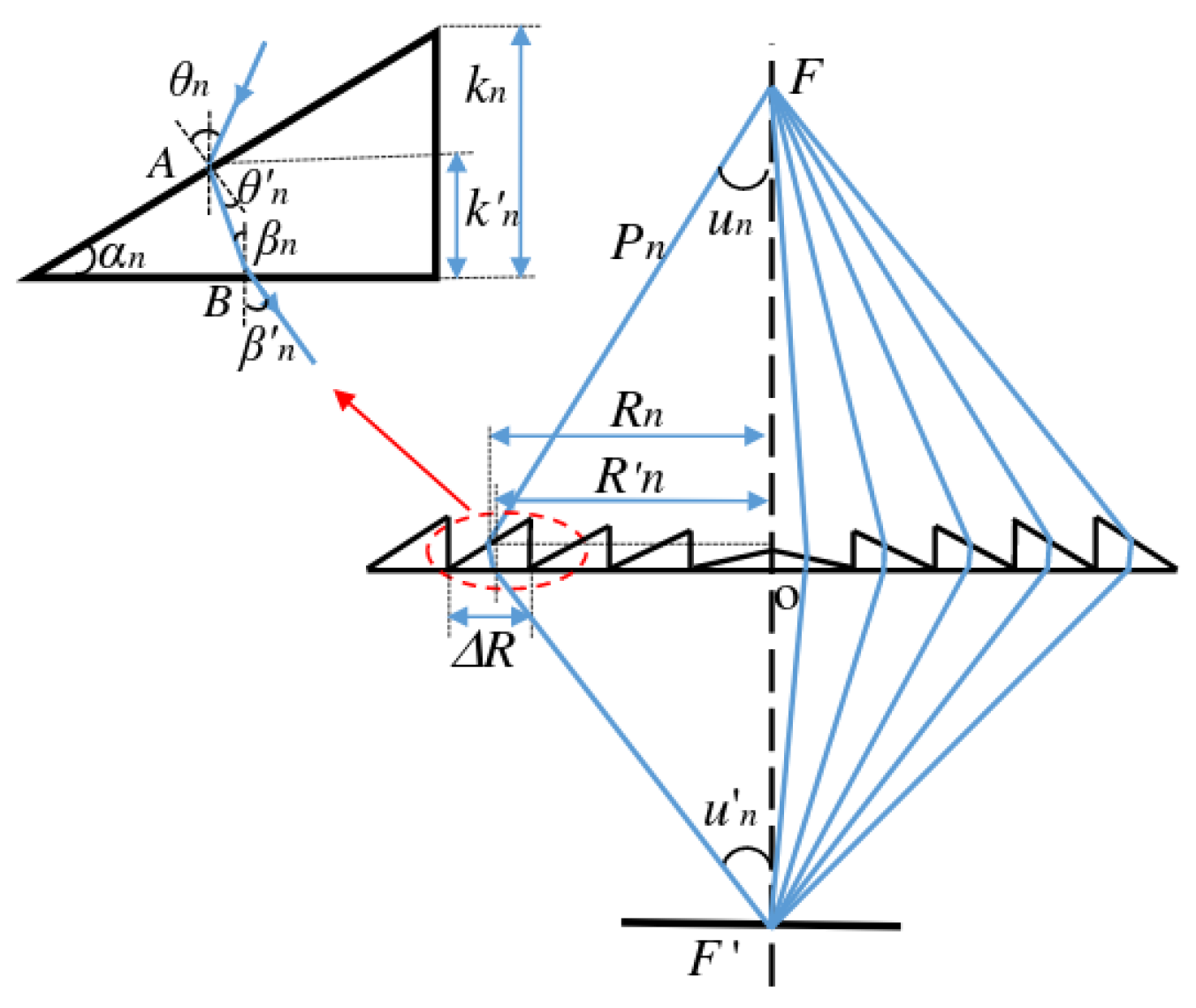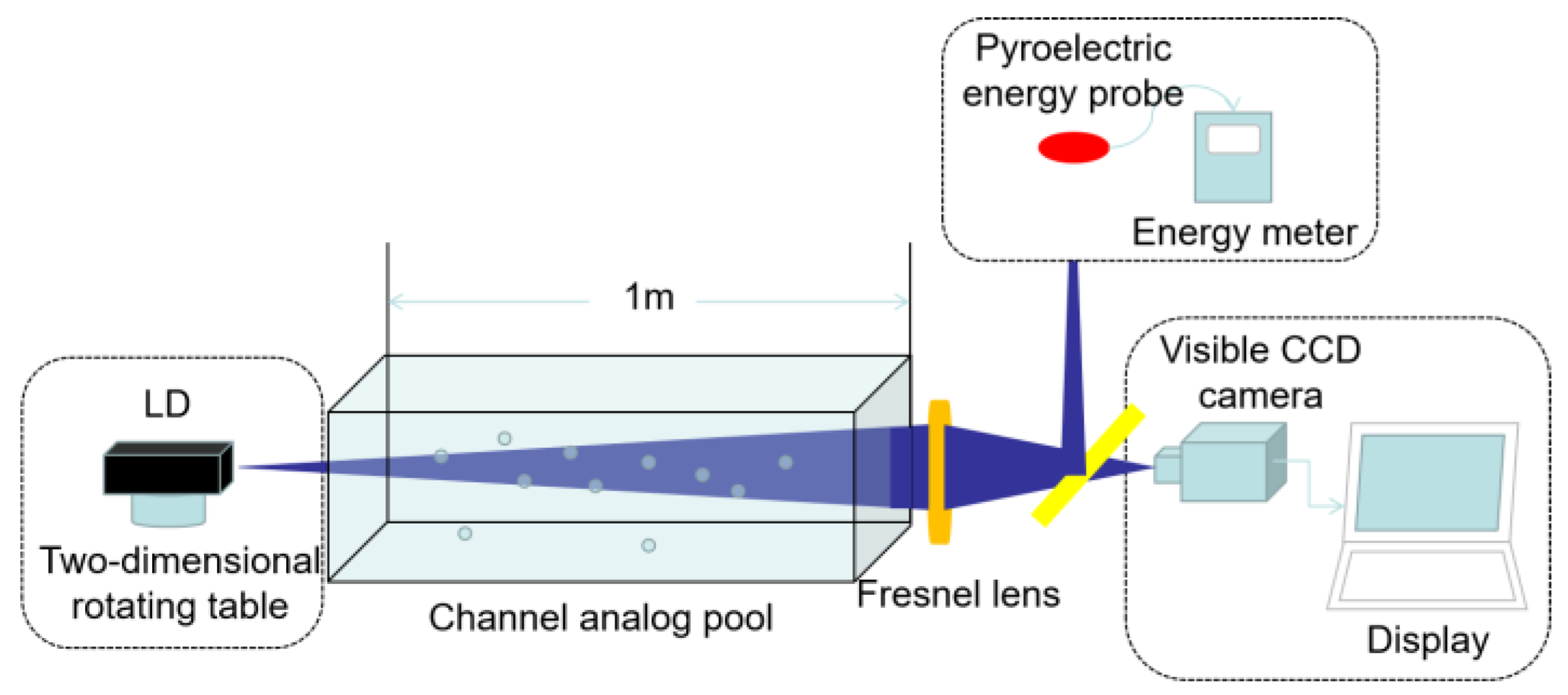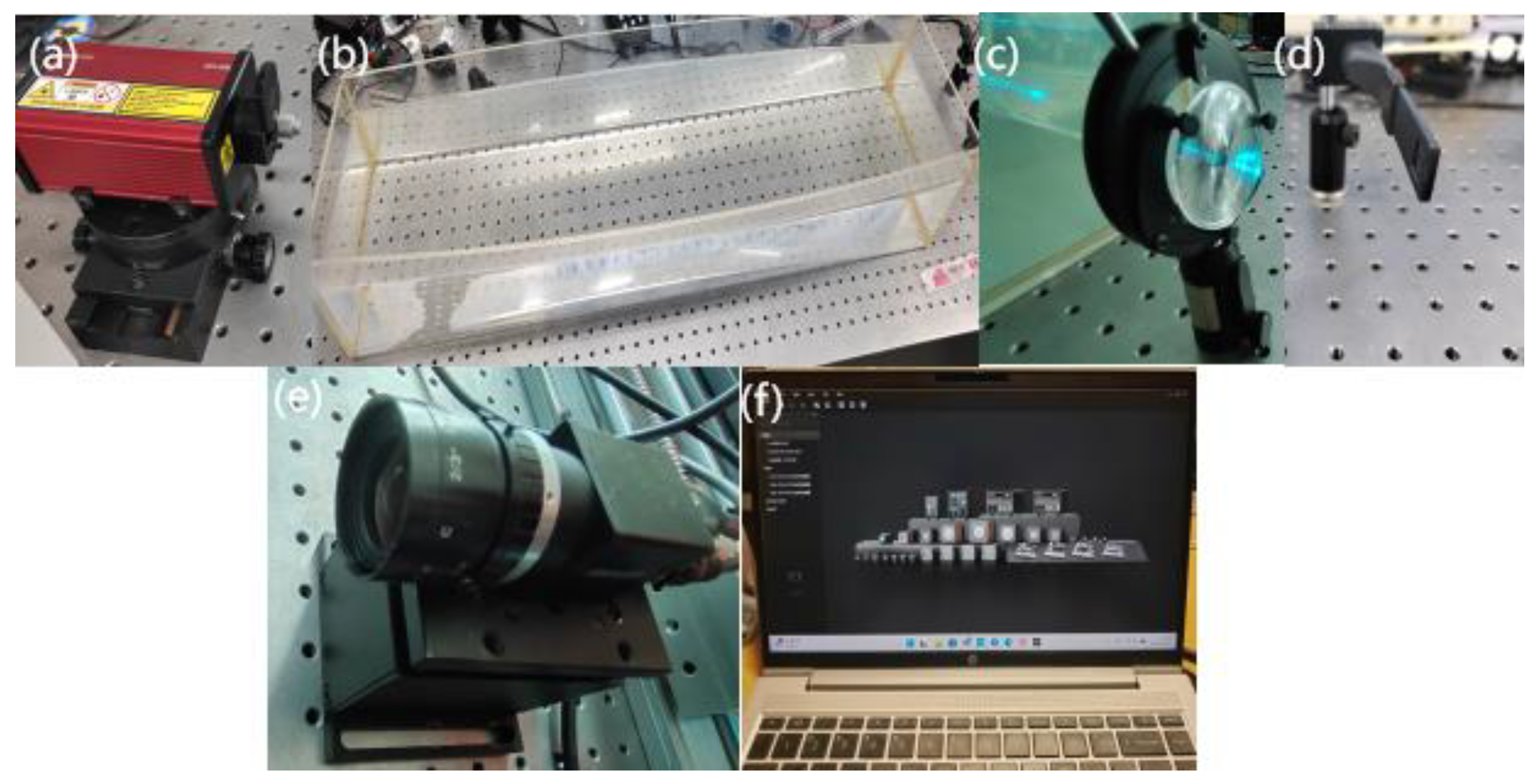Research on the Optical Receiving Performance of Underwater Wireless Optical Communication System Based on Fresnel Lens
Abstract
1. Introduction
2. Materials and Methods
2.1. Principle Experimental Analysis
2.1.1. The Principle of Fresnel Lens Focusing Light
2.1.2. Performance Parameters of Fresnel Lenses
2.2. Experimental Device
3. Results
4. Discussion
5. Conclusions
Author Contributions
Funding
Institutional Review Board Statement
Informed Consent Statement
Data Availability Statement
Conflicts of Interest
References
- Zhou, H.; Zhang, M.; Wang, X.; Ren, X. Design and Implementation of More Than 50m Real-Time Underwater Wireless Optical Communication System. J. Light. Technol. 2022, 40, 3654–3668. [Google Scholar] [CrossRef]
- Omar, N.M.S.; Salah, A.A.; Ammar, H.M. Underwater optical wireless communication system performance improvement using convolutional neural networks. AIP Adv. 2023, 13, 045302. [Google Scholar] [CrossRef]
- Ge, W.; Song, G.; Qin, S.; Zhang, Y.; Du, Z.; Xu, J. Weak signal detection based on pulse width counting method for underwater wireless optical communication with an analog mode PMT detector. Opt. Express 2024, 32, 23404–23415. [Google Scholar] [CrossRef]
- Li, D.C.; Chen, C.C.; Liaw, S.K.; Afifah, S.; Sung, J.Y.; Yeh, C.H. Performance Evaluation of Underwater Wireless Optical Communication System by Varying the Environmental Parameters. Photonics 2021, 8, 74. [Google Scholar] [CrossRef]
- Cai, R.; Zhang, M.; Dai, D.; Shi, Y.; Gao, S. Analysis of the Underwater Wireless Optical Communication Channel Based on a Comprehensive Multiparameter Model. Appl. Sci. 2021, 11, 6051. [Google Scholar] [CrossRef]
- Liu, A.; Zhang, R.; Lin, B.; Yin, H. Multi-Degree-of-Freedom for Underwater Optical Wireless Communication with Improved Transmission Performance. J. Mar. Sci. Eng. 2023, 11, 48. [Google Scholar] [CrossRef]
- Zayed, M.M.; Shokair, M.; Elagooz, S.; Elshenawy, H. Feasibility analysis of line of sight (LOS) underwater wireless optical communications (UWOCs) via link budget. Opt. Quant Electron 2024, 56, 1012. [Google Scholar] [CrossRef]
- Simpson, J.A.; Hughes, B.L.; Muth, J.F. Smart Transmitters and Receivers for Underwater Free-Space Optical Communication. Sel. Areas Commun 2012, 30, 964–974. [Google Scholar] [CrossRef]
- Oubei, H.M.; Duran, J.R.; Janjua, B.H.; Wang, Y.; Tsai, C.T.; Chi, Y.C.; Ng, T.K.; Kuo, H.C.; He, J.H.; Alouini, M.S.; et al. 4.8 Gbit/s 16-QAM-OFDM transmission based on compact 450-nm laser for underwater wireless optical communication. Opt. Express 2015, 23, 23302–23309. [Google Scholar] [CrossRef] [PubMed]
- Chen, Y.F.; Kong, M.W.; Ali, T.; Wang, J.J.; Sarwar, R.; Han, J.; Guo, C.Y.; Sun, B.; Deng, N. 26 m/5.5 Gbps air-water optical wireless communication based on an OFDM-modulated 520-nm laser diode. Opt. Express 2017, 25, 14760–14765. [Google Scholar] [PubMed]
- Wang, D.; Lan, T. Design of a gradient-index lens with a compound parabolic concentrator shape as a visible light communication receiving antenna. Appl. Opt. 2018, 57, 1510–1517. [Google Scholar] [CrossRef]
- Hu, S.Q.; Mi, L.; Zhou, T.H.; Chen, W.B. 35.88 attenuation lengths and 3.32 bits/photon underwater optical wireless communication based on photon-counting receiver with 256-PPM. Opt. Express 2018, 26, 21685–21699. [Google Scholar] [CrossRef]
- Sabbagh, A.G. Long-range underwater optical wireless communication systems in turbulent conditions. Opt. Express 2023, 31, 21311–21329. [Google Scholar] [CrossRef]
- Qi, Z.; Wang, L.; Liu, P.; Bai, M.; Yu, G.; Wang, Y. Full-duplex underwater wireless blue light communication. Opt. Express 2023, 31, 9330–9338. [Google Scholar] [CrossRef] [PubMed]
- Han, S.; Yue, P.; Yi, X. Study of an underwater accurate channel model considering comprehensive misalignment errors. J. Opt. Soc. Am. 2022, 39, 1014–1024. [Google Scholar] [CrossRef]
- Ke, X.; Yang, S.J.; Sun, Y.; Liang, J.Y.; Pan, X.Y. Underwater blue-green LED communication using a double-layered, curved compound-eye optical system. Opt. Express 2022, 30, 18599–18616. [Google Scholar]
- Manimegalai, C.T.; Bhatta, H.; Thakur, H.; Iliyas, A. Channel modeling for UWOC: A simulation approach. J. Opt. 2022, 51, 810–818. [Google Scholar] [CrossRef]
- Fei, C.; Wang, Y.; Du, J.; Chen, R.L.; Lv, N.F.; Zhang, G.W. 100-m/3-Gbps underwater wireless optical transmission using a wideband photomultiplier tube (PMT). Opt. Express 2022, 30, 2326–2337. [Google Scholar] [CrossRef] [PubMed]
- Zhao, M.; Miyamoto, T. Optimization for Compact and High Output LED-Based Optical Wireless Power Transmission System. Photonics 2022, 9, 14. [Google Scholar] [CrossRef]
- Wang, M.; Yu, J.; Zhao, X.; Bian, C.; Zhou, W.; Wang, K. K-Means Non-Uniform-Quantization Digital–Analog Radio-over-Fiber Scheme for THz-Band Photonics-Aided Wireless Fronthaul. Opt. Lett. 2024, 49, 2801–2804. [Google Scholar]
- Lu, W.W.; Chen, S.Y.; Xiong, Y.P.; Liu, J.F. A single ball lens-based hybrid biomimetic fish eye/compound eye imaging system. Opt. Commun. 2021, 480, 126458. [Google Scholar] [CrossRef]
- Kumar, V.; Shrivastava, R.; Untawale, S. Fresnel Lens: A Promising Alternative of Reflectors in Concentrated Solar Power. Renew. Sustain. Energy Rev. 2015, 44, 376–390. [Google Scholar] [CrossRef]
- Tan, N.Y.J.; Zhang, X.; Neo, D.W.K.; Huang, R.; Liu, K.; Kumar, A.S. A Review of Recent Advances in Fabrication of Optical Fresnel Lenses. J. Manuf. Process. 2021, 71, 113–133. [Google Scholar] [CrossRef]
- Dhanumalayan, E.; Joshi, G.M. Performance Properties and Applications of Polytetrafluoroethylene (PTFE)—A Review. Adv. Compos. Hybrid Mater. 2018, 1, 247–268. [Google Scholar] [CrossRef]
- Price, D.M.; Jarratt, M. Thermal Conductivity of PTFE and PTFE Composites. Thermochim. Acta 2002, 392, 231–236. [Google Scholar] [CrossRef]
- Yeh, N.; Yeh, P. Analysis of Point-Focused, Non-Imaging Fresnel Lenses’ Concentration Profile and Manufacture Parameters. Renew. Energy 2016, 85, 514–523. [Google Scholar] [CrossRef]
- Shaw, J.A. Radiometry and the Friis Transmission Equation. Am. J. Phys. 2013, 81, 33–37. [Google Scholar] [CrossRef]
- Nagatsuma, T.; Horiguchi, S.; Minamikata, Y.; Yoshimizu, Y.; Hisatake, S.; Kuwano, S.; Yoshimoto, N.; Terada, J.; Takahashi, H. Terahertz Wireless Communications Based on Photonics Technologies. Opt. Express 2013, 21, 23736–23747. [Google Scholar] [CrossRef] [PubMed]







Disclaimer/Publisher’s Note: The statements, opinions and data contained in all publications are solely those of the individual author(s) and contributor(s) and not of MDPI and/or the editor(s). MDPI and/or the editor(s) disclaim responsibility for any injury to people or property resulting from any ideas, methods, instructions or products referred to in the content. |
© 2025 by the authors. Licensee MDPI, Basel, Switzerland. This article is an open access article distributed under the terms and conditions of the Creative Commons Attribution (CC BY) license (https://creativecommons.org/licenses/by/4.0/).
Share and Cite
Zhao, Y.; Hong, S.; Zhang, Z.; Zhu, X.; Zhang, P. Research on the Optical Receiving Performance of Underwater Wireless Optical Communication System Based on Fresnel Lens. Photonics 2025, 12, 1010. https://doi.org/10.3390/photonics12101010
Zhao Y, Hong S, Zhang Z, Zhu X, Zhang P. Research on the Optical Receiving Performance of Underwater Wireless Optical Communication System Based on Fresnel Lens. Photonics. 2025; 12(10):1010. https://doi.org/10.3390/photonics12101010
Chicago/Turabian StyleZhao, Ya, Shixiang Hong, Zhanqi Zhang, Xiaoxuan Zhu, and Peng Zhang. 2025. "Research on the Optical Receiving Performance of Underwater Wireless Optical Communication System Based on Fresnel Lens" Photonics 12, no. 10: 1010. https://doi.org/10.3390/photonics12101010
APA StyleZhao, Y., Hong, S., Zhang, Z., Zhu, X., & Zhang, P. (2025). Research on the Optical Receiving Performance of Underwater Wireless Optical Communication System Based on Fresnel Lens. Photonics, 12(10), 1010. https://doi.org/10.3390/photonics12101010




